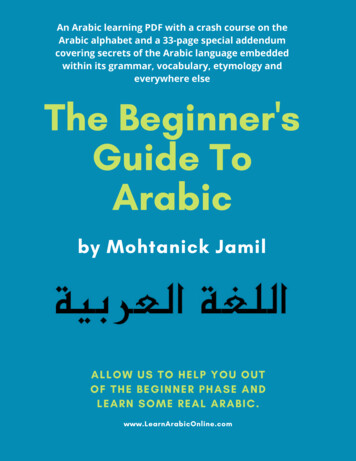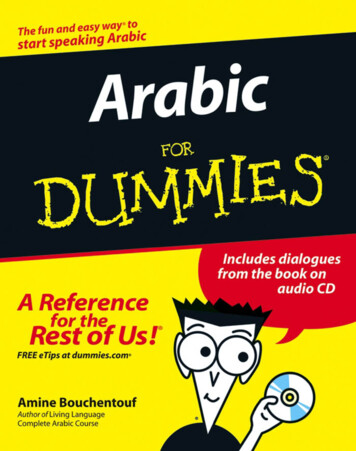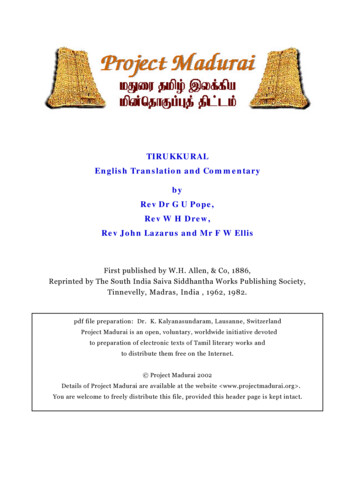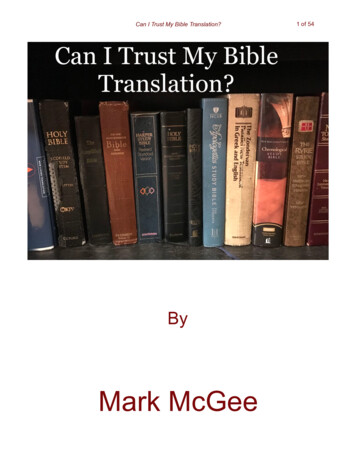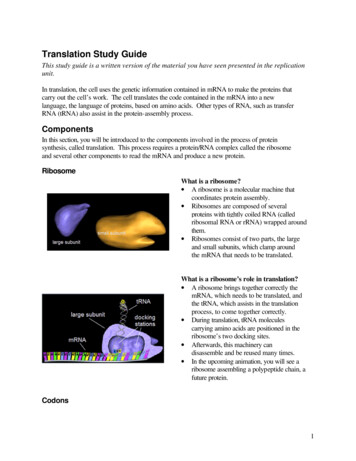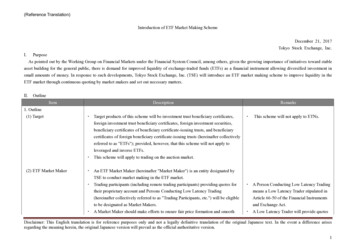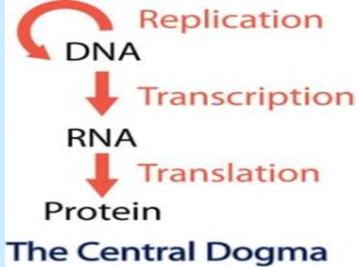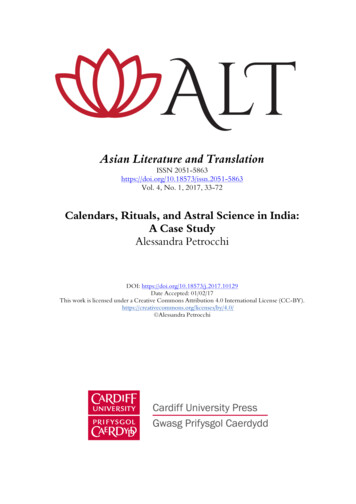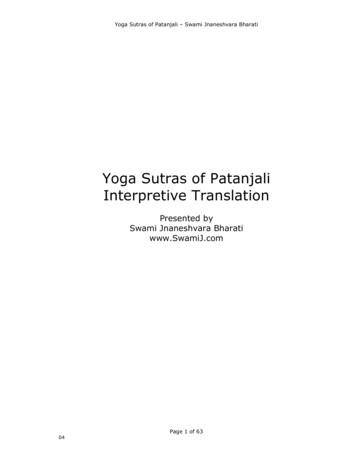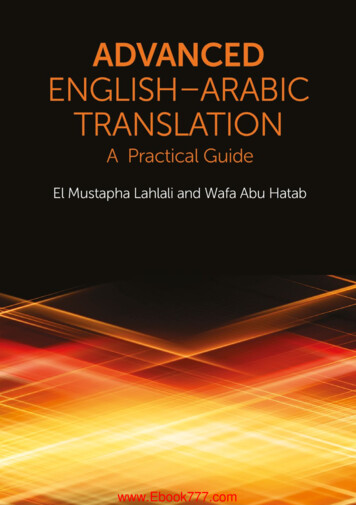
Transcription
Free ebooks www.Ebook777.com1www.Ebook777.com
AdvancedEnglish–Arabic Translation
Free ebooks www.Ebook777.comwww.Ebook777.com
AdvancedEnglish–Arabic TranslationA Practical GuideEl Mustapha Lahlali and Wafa Abu Hatab
Free ebooks www.Ebook777.com El Mustapha Lahlali and Wafa Abu Hatab, 2014Edinburgh University Press LtdThe Tun - Holyrood Road, 12(2f) Jackson’s Entry, Edinburgh EH8 8PJwww.euppublishing.comTypeset in Times New Roman byServis Filmsetting Ltd, Stockport, Cheshireand printed and bound in Great Britain byCPI Group (UK) Ltd, Croydon CR0 4YYA CIP record for this book is available from the British LibraryISBN 978 0 7486 4584 8 (hardback)ISBN 978 0 7486 7796 2 (webready PDF)ISBN 978 0 7486 4583 1 (paperback)ISBN 978 0 7486 7798 6 (epub)The right of El Mustapha Lahlali and Wafa Abu Hatab to be identifiedas Author of this work has been asserted in accordance with theCopyright, Designs and Patents Act 1988, and the Copyright andRelated Rights Regulations 2003 (SI No. 2498).www.Ebook777.com
ContentsAcknowledgementsUsing this BookKey to SymbolsStructure of the BookMap of the BookModule 1: Foundation Methods of TranslationLesson 1: Word-for-word translationLesson 2: Literal translationLesson 3: Faithful translationLesson 4: Communicative translationLesson 5: AdaptationLesson 6: Free translationModule review exercisesModule 2: Literary TextsLesson 7: FictionLesson 8: Narrative texts: discourse problemsLesson 9: Narrative texts: syntactic problemsLesson 10: C ultural problems, domestication andLesson 10: foreignisationLesson 11: DramaLesson 12: PoetryModule review exercisesModule 3: Economics TextsLesson 13: NeologismLesson 14: Metaphors in economic discourseLesson 15: Terminology: marketingLesson 16: Terminology: investmentLesson 17: Terminology: bankingLesson 18: Terminology: accounting and auditModule review 5557616467717682
Free ebooks www.Ebook777.comAdvanced English–Arabic TranslationModule 4: Scientific TextsLesson 19: Translation strategiesLesson 20: Translation problems and practical stepsLesson 21: Translation problems: more practiceLesson 22: Problems of word level equivalenceLesson 23: Problems above word level equivalenceLesson 24: T extual equivalence: cohesion and coherenceModule review exercisesModule 5: Media TextsLesson 25: Conflicts/Civil WarsLesson 26: Uprisings and revolutionsLesson 27: Elections and oppositionsLesson 28: Natural disastersModule review exercisesModule 6: Administrative TextsLesson 29: Translating guidelines and regulationsLesson 30: Learning and teaching regulationsModule review exercisesModule 7: Legal TextsLesson 31: Translating legal textsLesson 32: Translating agreements and contractsLesson 33: Security Council: terms and conditions andLesson 33: peace agreementsModule review 777.com
AcknowledgementsWe would like to express our gratitude to all those who have made this book possible.We wish to thank first and foremost our colleagues at the University of Leeds and atZarqa University for their support and encouragement. We are deeply indebted to ourfamilies for their support and assistance throughout the writing stages of this book. Ourspecial thanks go also to our friends for their encouragement and support.Our sincere thanks also go to Dr Jalal Aldoseri for his valuable comments on adraft of this book.vii
Free ebooks www.Ebook777.comUsing this BookThe need for translation from English into Arabic and vice versa has grown substantially since 9/11 and the war on Iraq in 2003. Such a need has increased demands fortranslation services from and into these two languages. Unfortunately, the educationalmarket has suffered from a lack of textbooks that address translation from a practicalpoint of view, taking into consideration the changing nature of the translation marketon social, economic and political levels. Translation is a highly demanding processthat involves much more than utilising and converting words and phrases from onelanguage into another, and translators and learners need a practical book that addressesthe skills and sub-skills of translation: this book is designed to address some of theseneeds.This book introduces learners to translation from English into Arabic througha wide range of practical exercises. With a variety of texts and multiple drills, it ishoped that learners will be able to develop and refine their translation skills. The bookintroduces learners to drills related to the translation of texts within basic genres, andcovering translation sub-skills. It aims to present an efficient and practical approach tolearning the skills of translating different text types from English into Arabic. Whilstmost of the published translation books tend to focus on the theoretical aspects oftranslation from the source text (ST) to the target text (TT), this book follows a practice-based approach in order to assist learners in utilising the concepts and theoreticalframeworks they have learned. Some theoretical aspects of translation are introducedin the first four modules, but readers are urged to consult other books that elaborate atlength on these theoretical aspects.As well as offering advanced materials for translation from English into Arabic,the book also includes a wide range of drills pinpointing the differences between thesource language (SL) and the target language (TL) so that learners and translators canrefresh their knowledge of some aspects of the TL.Not only will the book be useful to those learners who wish to familiarise themselves with the different typology of Arabic and English texts, it will also equip themwith some necessary translation skills. Furthermore, the book introduces students togeneral translation skills by focusing on specific technical texts that require certain‘detective’ skills, which students learn through the practical drills offered on each text.These drills are designed to help learners progress through the word level, sentencelevel and discourse level. Since context is at the heart of translation, students are introduced to a variety of drills that allow them to translate different elements of discoursein their appropriate context.It is hoped that the practical drills will enhance learners’ skills in selecting appropriate equivalence to the ST, especially in the translation of technical texts. In additionto mastering knowledge of both languages, translators need to have a good commandviiiwww.Ebook777.com
Using this bookof specific registers, some of which will be acquired through specialised dictionaries,encyclopaedias and technical literature in both languages. In order to facilitate learners’ comprehension and translation of texts, a glossary of some technical words andphrases is provided at the end of each text. On completing this book, learners shouldhave acquired technical vocabulary at an advanced level, further enhancing their abilityto translate from English into Arabic.All in all, this book is intended to improve and strengthen learners’ translationskills, and refine and expand their knowledge of different genres of texts. The mainobjectives can be summarised as follows:1. introducing learners to the main features of different genres of texts2. identifying the linguistic and cultural features of different text types3. equipping learners with the necessary skills to deal with the translation of differentgenres of texts from English into Arabic, through practical translation drills4. enhancing awareness of pragmatic, semantic and sociolinguistic aspects during thetranslation process.Key to SymbolsAZGlossaryTranslationix
Free ebooks www.Ebook777.comStructure of the BookThis book is composed of seven modules. The first four modules examine variousaspects of translating different genres into Arabic. A range of drills then follows, whichare designed to help learners digest these concepts. Modules 5, 6 and 7, however, aremore practical. They offer drills and exercises to help students practise some of thetheoretical concepts introduced in Modules 1, 2, 3 and 4, and apply them to differenttext genres. With this in mind, each module starts with an overview of the genre inquestion and is followed with drills and exercises to help learners practise the translation strategies outlined. Before they are tackled in detail, Module 1 will cover thecommon strategies of translation in order to acquaint learners with the various waysthey can translate their texts.The modules are:1. Foundation Methods of TranslationThis module introduces students to some of the main translation approaches and frameworks that students would find useful in translating different texts. These approachesare not comprehensive but representative of the main translation approaches used inthe field.2. Literary TextsThis module introduces students to literary texts and literary translation from Englishinto Arabic, covering poetry, fiction and drama. Characteristics of each type of literarytext are illustrated along with translated examples, mainly from English into Arabic.3. Economics TextsThis module deals with the translation of texts on economics and finance as well asother issues dealt with in business language.4. Scientific TextsThis module deals with the translation of scientific texts in areas such as medicine,physics, chemistry and psychology. Learners are shown how to deal with scientificdiscourse using the appropriate terminology and linguistic structures.5. Media TextsThis module introduces the learner to a range of media texts. The main objective isto allow learners to familiarise themselves with the media register and to refine theirtranslation skills. The module also introduces the main features of media texts.6. Administrative TextsModules 6 and 7 are related. This module introduces students to administrative textsand provides learners with glossaries to help with their translation of texts in this genre.xwww.Ebook777.com
Structure of the Book7. Legal TextsThis module introduces learners to the main features and characteristics of legal textsincluding civil law documents, business contracts, court documents and orders, international legal documents and resolutions, civil partnership documents, internationaltreaties and conventions. A general introduction to the main features of legal texts, aswell as the challenges of translating within this genre, is also provided.xi
Free ebooks www.Ebook777.comMap of the BookModule andTopicTranslation Methodsand StrategiesGenreTranslation ExercisesModule 1:FoundationMethods ofTranslationMethods of Translation:1. Word-for-wordtranslation.2. Literal Translation.3. Faithful Translation.4. CommunicativeTranslation.5. Adaptation.6. Free Translation.Literary TextsPoemsTexts with culturespecific problemsQuotesProverbsModule reviewexercises.Translation from Englishinto Arabic.Translation texts fromArabic into English to getmore acquainted with thedifferences between SLand TL.Module 2:Literary Texts1. Adaptation2. CommunicativeTranslation3. Domestication4. ForeignizationFeatures of literary textsFictionPoetryDramaModule reviewexercises.Translating texts from shortstories and novels intoEnglish, applying translationstrategies.Identifying cohesive devicesand syntactic differencesbetween SL and TL.Identifying and translatingfigures of speech.Syntactic,Discourse andCultural Problems.Module 3:EconomicsTextsFeatures of Economic TextsMarketingInvestmentBankingAccounting and AuditModule reviewexercises.Translating economicstexts into English, payingattention to numbers andfigures, false cognates andother translation problems.Translating texts thatrepresent the basiceconomics genre.EconomicsTerminology.Metaphors.False cognates.Module 4:Scientific Texts1. Borrowing.2. Coinage.3. Arabization.4. Naturalization.Features of Scientific texts.ChemistryMedicineBiologyEpidemiologyModule reviewexercises.Translating scientific texts.Applying some of thestrategies introduced inmodule 1 to scientific texts.Word levelequivalence.Above word levelequivalence.Textual equivalenceModule 5:Media TextsFeatures of Media Texts.Conflicts/civil wars.Uprisings andrevolutions.Elections andopposition.Natural disasters.Module reviewexercises.Translation from Englishinto Arabic.Translation of some extractsfrom Arabic into English.Wide range of drills ontranslating media texts.Summaries of texts into TL.Syntactic problems.Culture-specificproblems.Module 6:AdministrativeTextsFeatures of administrativetexts.Translating guidelinesand regulations.Learning and teachingregulations.Glossaries from Englishinto Arabic.Module reviewexercises.Translating texts fromArabic into English.Translating texts fromEnglish into Arabic.Applying some translationstrategies to translatingadministrative texts.Identifying and rectifyingtranslation errors.Module 7:Legal TextsMain features of legaltexts.Types of legal texts.Translating agreementsand contracts.Security council: Termsand conditions.Peace Agreements.Glossaries English intoArabic.Module reviewexercises.Translating legal texts intoEnglish.Translating legal texts intoArabic.Applying some of thetranslation strategiesintroduced in module 1.Identifying translation ctic problems.Culture-specificproblems.
MODULE 1Foundation Methods of TranslationBefore we discuss types of translation, a distinction should be first made betweentranslation methods (or strategies) and translation procedures (or techniques). ‘Whiletranslation methods relate to whole texts, translation procedures are used for sentences and the smaller units of language’ (Newmark 1988a: 81). Methods of translation are classified into six types: word-for-word translation, literal translation, faithfultranslation, communicative translation, adaptation and free translation. These will beexplained below wit
have acquired technical vocabulary at an advanced level, further enhancing their ability to translate from English into Arabic. All in all, this book is intended to improve and strengthen learners’ translation skills, and refine and expand their knowledge of different genres of texts. The main objectives can be summarised as follows: 1 .
